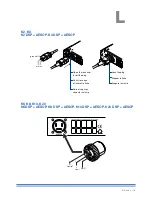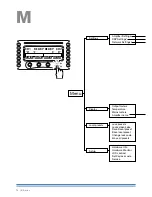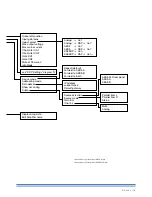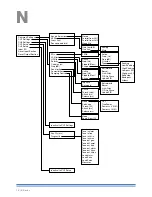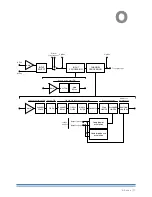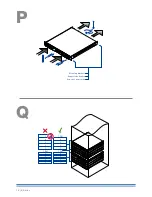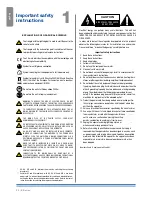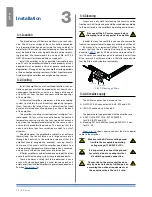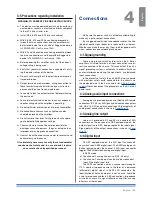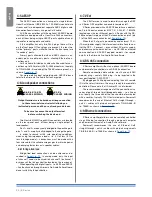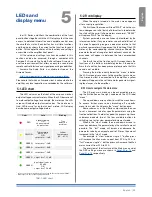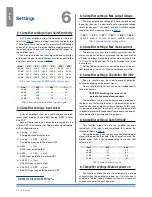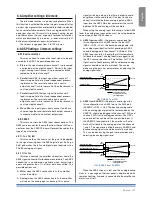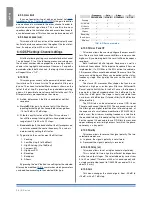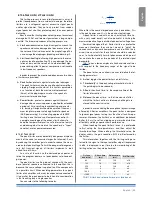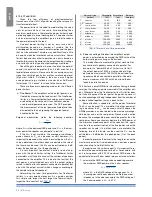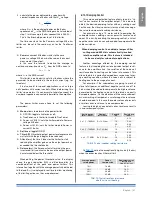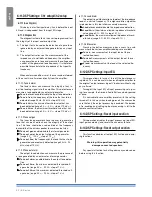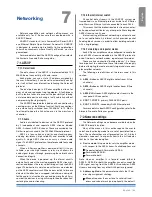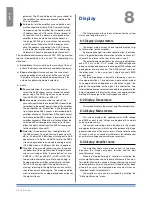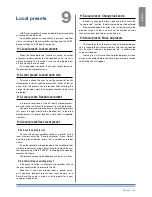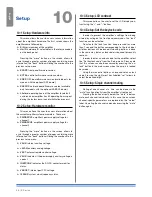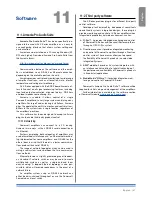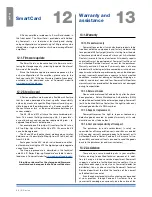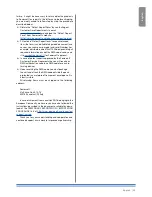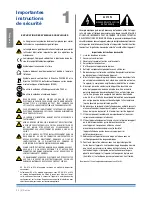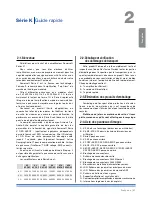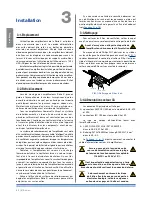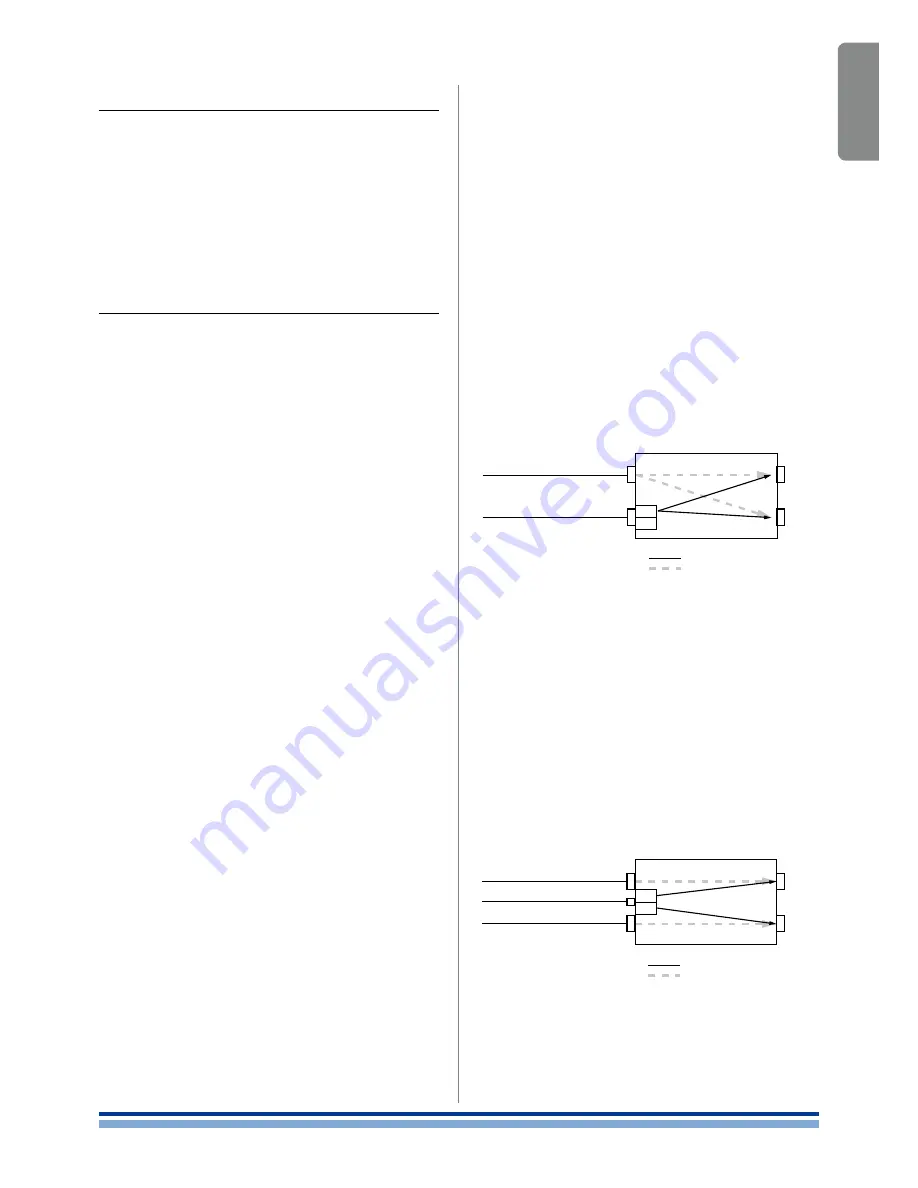
En
gl
ish
6 : 8.Amplifier settings: Idle mode
The idle mode function is a power saving feature. When
this function is activated, the output stage is turned off after
no input signal greater than a selected threshold is detected
for a user selectable amount of time, saving about 40 W of
power per channel. This results in reduced heating, longer
amplifier and fans life, and, especially for fixed installations
which are permanently turned on, a lower electricity bill.
Exiting from idle mode is quasi-instantaneous.
The timeout range goes from 0 to 720 minutes.
6 : 9.DSP Settings: Common settings
6 : 9.1. Source selection
This menu allows to choose the input signal to be pro-
cessed by the DSp. The possible options are:
f
f
Stereo
: the signal coming from channel 1 is processed
and routed out to output channel 1. Similarly, the input
signal coming from channel 2 is processed and then
routed out to output channel 2.
f
f
Parallel from CH1
: the input signal from channel 1
feeds two parallel, distinct and independent process-
ing branches. The result of one branch is sent to
output channel 1, while the result of the other branch is
sent to output channel 2.
f
f
Parallel from CH2
: the input signal from channel 2
feeds two parallel, distinct and independent process-
ing branches. The result of one branch is sent to
output channel 1, while the result of the other branch is
sent to output channel 2.
f
f
Mono Mix
: the input signals from channel 1 and 2 are
summed together and routetd to both output channels
in order to maintain a consistent output level.
6 : 9.2. AES3
This menu controls the aES3 input stream options. The
aES3 source can enter the amplifier from the rear XLr con-
nector or from the kaESOp board (if present) based on the
type of input selection.
6 : 9.2.1. Gain trim (dB)
This menu allows the user to set the gain to be applied
to the signal coming from the aES3 digital input. Setting a
0 dB gain makes the full-scale digital signal equivalent to a
20 dBu analog input signal.
6 : 9.2.2. If no link
This menu controls the amplifier’s behavior should the
aES3 signal connection fail or become unreliable. The aES3
connection is considered unreliable when transmission
errors are greater than 1% of total data transmitted. The
possible options are:
f
f
Mute
: when the aES3 connection fails, the amplifier
mutes the output.
f
f
Analog
: when the aES3 connection fails, the amplifier
will rely on the analog input as backup. This source
signal switching is done in real time in order to avoid
any glitches in the audio feed. if the input levels are
correctly matched between analog input and aES3
input (use the aES3 Gain trim parameter), the switch
between aES3 and analog will be inaudible.
When using the analog input to backup a failed aES3
feed, the analog input connection must be setup based on
source type of input aES3 stream:
f
f
AES3 from rear XLR
– the primary audio signal for
this configuration is an aES3 fed via the rear XLr
(aES3
DSp
Out). The backup analog cable, with
an analog signal identical to that provided by aES3,
should be plugged in the channel 1 XLr input. if the
aES3 feed should fail, the amplifier will automatically
fall back to channel 1 analog input (we suggest to set
the DSp source selection to “parallel from cH1”). The
signal levels of both primary aES3 and backup analog
signals should be carefully matched. This can be
done using the gain trim parameter or by adjusting the
analog signal level.
f
f
AES3 from KASEOP
– the primary audio signal for
this configuration is an aES3 fed via the rJ45 port
(kaESOp
DSp
Out). The backup analog cable,
with an analog signal identical to that provided by the
kaESOp, should be plugged in the channel 1 XLr and
channe 2 XLr (set to analog) connectors. The DSp’s
source selection can be set to any possible input. if
the kaESOp feed should fail, the amplifier will auto-
matically fall back to the analog input on the channels
1 and 2. The signal levels of both primary kaESOp and
backup analog signals should be carefully matched.
This can be done using the gain trim parameter or by
adjusting the analog signal level.
When the aES3 stream is lost and the analog backup
kicks in, a message on the front panel is displayed and if a
remote client (e.g. armonía) is connected to the amplifier, an
alarm is sent to it.
DSP Source Selection mode: Parallel from CH1
main digital connection
analog backup connection
(used if digital fails)
IN2
(analog)
carrying the same signal as the CH2 of the AES3 feed
carrying the same signal as the CH1 of the AES3 feed
IN1
(analog)
CH1 out
CH2 out
Analog back up cabling
Analog back up cabling
Main digital AES3 stream via RJ-45
CH1
CH2
Analog back up cabling
carrying the same signal as the CH1 of the AES3 feed
Digital main cabling
IN1
(analog)
IN2
(AES/EBU)
CH1
CH2
DSP Source Selection mode: Parallel from CH1
main digital connection
analog backup connection
(used if digital fails)
CH1 out
CH2 out
DSP Source Selection mode: Parallel from CH1
main digital connection
analog backup connection
(used if digital fails)
IN2
(analog)
carrying the same signal as the CH2 of the AES3 feed
carrying the same signal as the CH1 of the AES3 feed
IN1
(analog)
CH1 out
CH2 out
Analog back up cabling
Analog back up cabling
Main digital AES3 stream via RJ-45
CH1
CH2
Analog back up cabling
carrying the same signal as the CH1 of the AES3 feed
Digital main cabling
IN1
(analog)
IN2
(AES/EBU)
CH1
CH2
DSP Source Selection mode: Parallel from CH1
main digital connection
analog backup connection
(used if digital fails)
CH1 out
CH2 out
FIG. 2: AES3 from XLR.
DSP Source Selection mode: Parallel from CH1
main digital connection
analog backup connection
(used if digital fails)
IN2
(analog)
carrying the same signal as the CH2 of the AES3 feed
carrying the same signal as the CH1 of the AES3 feed
IN1
(analog)
CH1 out
CH2 out
Analog back up cabling
Analog back up cabling
Main digital AES3 stream via RJ-45
CH1
CH2
Analog back up cabling
carrying the same signal as the CH1 of the AES3 feed
Digital main cabling
IN1
(analog)
IN2
(AES/EBU)
CH1
CH2
DSP Source Selection mode: Parallel from CH1
main digital connection
analog backup connection
(used if digital fails)
CH1 out
CH2 out
DSP Source Selection mode: Parallel from CH1
main digital connection
analog backup connection
(used if digital fails)
IN2
(analog)
carrying the same signal as the CH2 of the AES3 feed
carrying the same signal as the CH1 of the AES3 feed
IN1
(analog)
CH1 out
CH2 out
Analog back up cabling
Analog back up cabling
Main digital AES3 stream via RJ-45
CH1
CH2
Analog back up cabling
carrying the same signal as the CH1 of the AES3 feed
Digital main cabling
IN1
(analog)
IN2
(AES/EBU)
CH1
CH2
DSP Source Selection mode: Parallel from CH1
main digital connection
analog backup connection
(used if digital fails)
CH1 out
CH2 out
FIG. 3: AES3 from KAESOP.
English | 27
Summary of Contents for K2 DSP+AESOP, K3 DSP+AESOP
Page 4: ...Page intentionally left blank 2 K Series...
Page 8: ...A K2 K3 K2 DSP AESOP K3 DSP AESOP 465 32 2 496 456 5 9 482 439 44 32 6 K Series...
Page 88: ...Page intentionally left blank 86 K Series...
Page 89: ...Page intentionally left blank Specifications 87...
Page 90: ...Page intentionally left blank 88 K Series...
Page 91: ......

